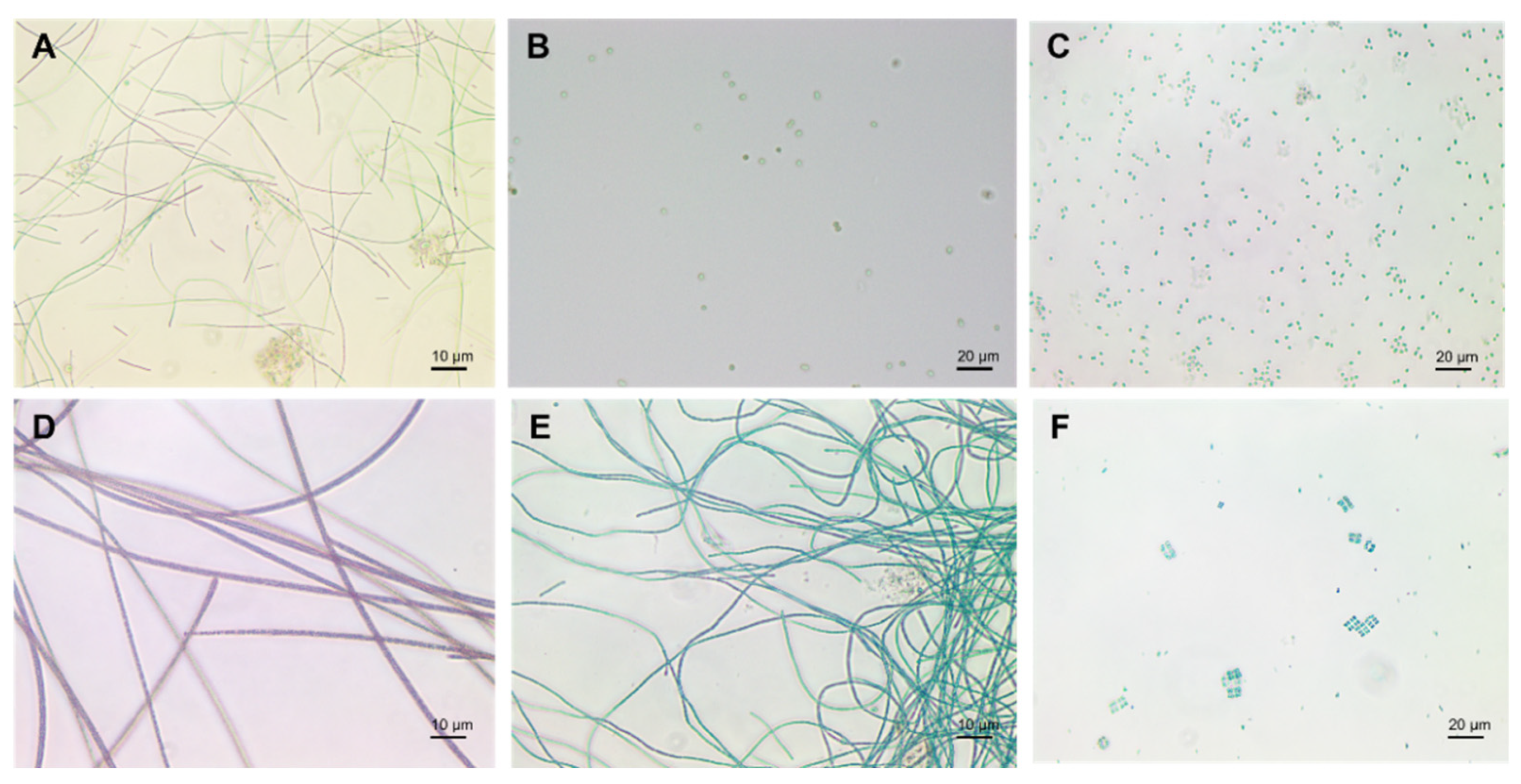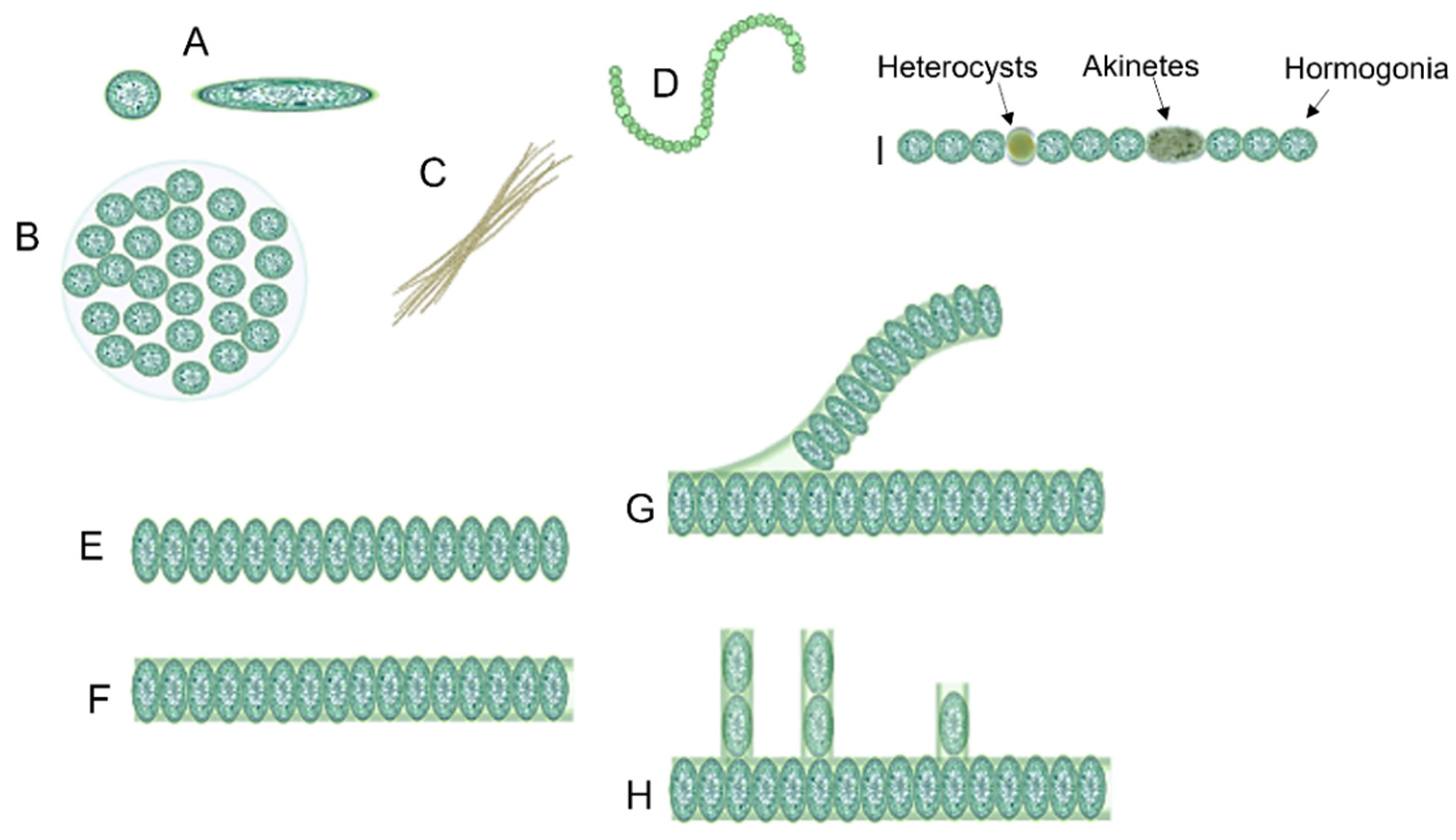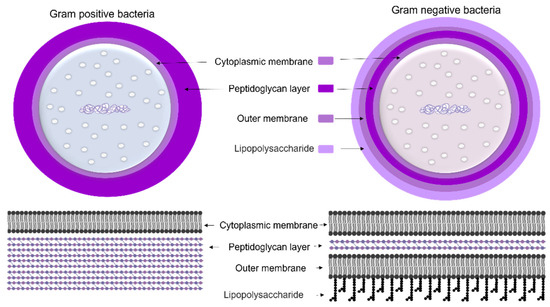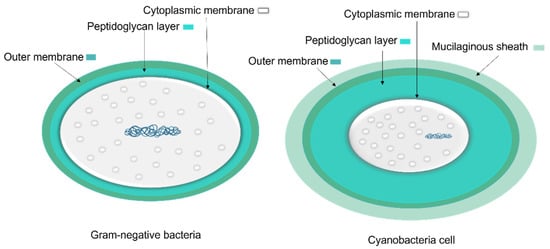Your browser does not fully support modern features. Please upgrade for a smoother experience.
Please note this is an old version of this entry, which may differ significantly from the current revision.
Cyanobacteria, also formerly called “blue-green algae”, are photosynthetic prokaryotes with ~3500 million years of existence on the planet earth. They live in a diverse range of environments, from freshwater and marine to terrestrial ecosystems. Cyanobacteria can tolerate and live in the most extreme habitats including geothermal habitats, frozen systems, and hypersaline environments.
- cyanobacteria
- Synechosystis
- microorganisms
- photosynthesis
- biofilm
- algal bloom
- photobioreactor
- motility
- run and tumble
- phototaxis
- active fluids
- rheology of active suspensions
1. Cyanobacteria
Cyanobacteria, also formerly called “blue-green algae”, are photosynthetic prokaryotes with ~3500 million years of existence on the planet earth [1][2]. They live in a diverse range of environments, from freshwater and marine [3] to terrestrial ecosystems [4]. Cyanobacteria can tolerate and live in the most extreme habitats including geothermal habitats [5], frozen systems [6], and hypersaline environments [7].
The number of cyanobacteria species is still a matter of debate and estimated to reach 8000 [8]. According to morphological characters and molecular analyses, hitherto, 5185 species have been identified and categorized: Chroococcales, Gloeobacterales, Nostocales, Oscillatoriales, Pleurocapsales, Spirulinales, and Synechococcales (Figure 1) [9].

Figure 1. Cyanobacteria classification [9].
Chroococcales contain coccoid unicelled and colonial cyanobacteria inside a mucilaginous envelope. The famous species in this order is the freshwater bloom-forming species Microcystis aeruginosa [10]. Gloeobacterales are unicellular or in irregular groups rod-shaped freshwater cyanobacteria that lack thylakoids [11]. The most identified cyanobacteria are filamentous species that belong to the order of Nostocales, and some species of this order have the ability to fix nitrogen [12][13]. The highest number of benthic linear filamentous species are associated with Oscillatoriales [13] and Pleurocapsales, which can be coccoid cells or resemble filaments (pseudo-filaments), can form complex colony formations [14][15]. Spirulinales members have screw-like coiled filaments while the species categorized in Synechococcales order contain both unicellular (plus colonial) and filamentous types [15][16]. Synechococcales has more than 70 genera and is considered to be the most abundant, ecologically significant, and oldest cyanobacteria. Synechocystis sp. is a member of Synechococcales [15][16].
In aquatic habitats, unicellular cyanobacteria are considered as an important group regarding abundance, diversity, and ecological character [15]. Cyanobacteria are also responsible for the primary rise of atmospheric oxygen around 2.3 billion years ago [17] and are known as the key organisms for fixing nitrogen [18]. Recently, cyanobacteria have gained interest in producing bioenergy and valuable biocompounds. Therefore, the development of engineered cyanobacteria has attracted a great deal of attention in the last two decades [15]. One of the most popular single-cell model organisms for genetic, physiological studies of photosynthesis, and energy research is a unicellular freshwater cyanobacterium known as Synechocystis [19][20]. The entire genome of Synechocystis sp. PCC 6803, as the first phototrophic organism and the fourth organism in general, was completely sequenced in 1996 [19][21].
Cyanobacteria exist in different morphologies including, unicellular, colonial, and multicellular filamentous forms (Figure 2) [22]. Their cell size varies from less than 1 µm in diameter (Picocyanobacteria) up to 100 µm (some tropical forms in the genus Oscillatoria) [3][23][24].

Figure 2. Cyanobacteria: (A) Plecctonema, (B) Synechocystis, (C) Microcystis, (D) Planktothrix, (E) Anabaena, (F) Merismopedia.
Unicellular cyanobacteria have spherical, ovoid, or cylindrical cells that may aggregate into irregular or regular colonies bound together by the mucous matrix (mucilage) secreted during the growth of the colony (Figure 3) [13][25]. Based on the species, the number of cells in each colony may vary from two to several thousand [15].

Figure 3. Different forms of cyanobacteria: (A) spherical and ovoid unicellular, (B) colonial, (C) filamentous, (D) spiral, (E) unsheathed trichome, (F) sheathed trichome, (G) false branching, (H) true branching, (I) different cell types in filamentous cyanobacteria.
After cell division, in filamentous cyanobacteria, the cells remain adhered to each other and form a chain known as “trichomes”, which can be enveloped in a mucous sheath in some taxa called filaments [13][26]. When trichomes break or fragment within a filament, false branches or “pseudobranches” are formed, which can exhibit in all cyanobacteria orders. However, in some members of Nostocales, cell division occurs perpendicular or obliquely in more than one plane leading to a true branching (Figure 3) [13][15][26].
Three different prevalent developmental cell types may differentiate from filamentous cyanobacteria vegetative cells, including hormogonia (motile cell type), heterocysts (nitrogen-fixing cell type), and akinetes (spore-like cells) (Figure 3) [27][28].
Hormogonia is a short chain of cyanobacterial filaments with gliding motility [29]. In some cyanobacteria species, hormogonia cells contain gas vacuoles to regulate buoyancy in the water column [30]. The major role of hormogonia is in the relocation and symbiotic colonization of hosts [26][30][31][32]. It was reported that the formation of hormogonia can be induced by the exchange of metabolites [33].
Heterocysts are large round-shaped cells with a thicker cell envelope in comparison with vegetative cells that are present in many multicellular cyanobacteria such as Anabaena and Nostoc and are specialized for fixing nitrogen [30][33].
Akinetes are perennating spore-like cells that can be formed under unfavorable growth conditions such as cold or drought [33]. Like heterocysts, akinetes have a thick cell wall [26]. It was hypothesized that akinetes are the evolutionary precursors of heterocysts [34].
2. Cyanobacteria’ Characteristics
2.1. Cyanobacteria’ Cell Membrane
To protect bacteria from the unpredictable and often hostile environment, their cells are enclosed by a complex multilayered structure. The structure of this layer is not similar for all bacteria and is divided into two major categories known as Gram-positive and Gram-negative, where Gram-positive bacteria are surrounded by a thick layer of peptidoglycan but lack an outer membrane. On the other hand, Gram-negative bacteria have a thin peptidoglycan cell wall, as well as an outer membrane containing lipopolysaccharide (Figure 4) [35].

Figure 4. The cell wall composition of Gram-positive and Gram-negative bacteria.
The cell wall composition of cyanobacteria is a specific group of Gram-negative bacteria [36] with a thin layer of peptidoglycan [37] and lipopolysaccharide outer membrane [38]. However, the cyanobacteria’s peptidoglycan layer is thicker (10–700 nm) compared to most Gram-negative bacteria (2–6 nm) (Figure 5) [37]. The thin peptidoglycan layer was reported in unicellular strains such as Synechococcus (~15 nm) [39], while in filamentous strains such as Oscillatoria princeps the thickness of this layer was reported more than 700 nm [40]. Aside from protection and sensing environmental stress, transport of nutrients and metabolites into and out of the cell is one of the major roles of the cellular membrane [37].

Figure 5. A comparison of general Gram-negative bacteria and cyanobacteria cell envelopes. The peptidoglycan layer in cyanobacteria is thicker than other Gram-negative bacteria and the mucilaginous sheath is present in some taxa.
Similar to Gram-negative bacteria, some cyanobacteria have extracellular non-flagellar appendages, called pili or fimbriae, which involve in motility, adhesion, biofilm formation, and uptake of DNA [41]. The pili are tube-like structures and have been characterized as type IV pili, which are protein polymers. In Synechocystis sp. PCC 6803, three different type IV pili were identified after negative staining, including thick pilus with 5–8 nm external diameter and more than 1–2 µm length; thin pilus with 2–4 nm external diameter and 0.5–1 µm length; and a bundle of pili [42][43].
2.2. Photosynthesis
Based on the occurrence, abundance, and morphological diversity, cyanobacteria are the largest group of photosynthetic prokaryotes [3], which, like higher plants, are capable of harvesting solar energy and performing photosynthesis through chlorophyll-a by fixing CO2 and generating O2 [2][44]. Cyanobacteria are responsible for a quarter of global carbon fixation, and suitable engineered photosynthetic microorganisms can increase the capacity of carbon fixation by capturing and storing CO2, and thereby stabilize or even reduce atmospheric CO2 levels [45].
In addition to chlorophyll-a (green pigment), cyanobacteria produce accessory photosynthetic blue and red pigments known as phycobilin (in particular phycocyanin (PC) and phycoerythrin (PE)), which enable them to grow under low-light conditions. They also produce carotenoids, which are known as a protective agent against photooxidative damages [22][46][47].
Quantitative determination of chlorophylls can be used as a proxy for photosynthesis, primary production, and phototaxonomic studies. However, under starvation, stress, and cell death, these pigments degrade rapidly [48]. Different cyanobacteria species, under various environmental parameters, are capable of producing various levels of these pigments [49].
Similar to eukaryotic cells, the photosynthetic apparatus of cyanobacteria is made of various units that absorb light energy and produce chemical bond energy such as reduced nicotinamide adenine dinucleotide phosphate (NADPH) and adenosine triphosphate (ATP) [50]. Chlorophyll-a contains reaction centers of photosystem I (PSI) and photosystem II (PSII). However, the major light-harvesting complex (LHC) in cyanobacteria, called the phycobilisome (PBS), is associated with the blue pigmented phycocyanin (Amax 620 nm), which absorbs photons in the orange-red part of the light spectrum, and the red-pigmented phycoerythrin (Amax 560 nm), which absorbs photons in the green-yellow part of the light spectrum, in conjunction with the PBS core of allophycocyanin (Amax 650 nm) (Figure 6) [50][51][52]. Though all PBS contain allophycocyanin and phycocyanin, some contain phycoerythrin [52].

Figure 6. Phycobilisome (PBS) structure is a combination of photosystem (PS), photosynthetic reaction center that contains chlorophyll-a and PC (phycocyanin, Amax 620 nm), PE (phycoerythrin, Amax 560 nm), and APC (allophycocyanin, Amax 650 nm).
Due to the modification in light intensity and wavelength, temperature, and nutrient availability, multiple regulatory processes evolve to prevent the overexcitation of photosynthesis reaction centers, which lead to the formation of reactive oxygen species (ROS) [53][54]. The produced ROS can damage cellular components and cause cell death; therefore, it is critical to balance light harvesting in the cell [54].
2.3. Production of Secondary Metabolites
Aside from the fact that cyanobacteria are mainly oxygen-producing photosynthetic microorganisms, they are also able to develop certain mechanisms to produce a wide variety of secondary metabolites with unique structural features and biological activities in versatile ecological niches including toxins, hormones, iron chelators, antibiotics, antifungal, inflammatory and anti-inflammatory compounds, antimicrobial, antineoplastic, and cytotoxic activities [55][56][57][58][59][60][61][62]. These secondary metabolites, in general, are associated with an organism’s interaction with its environment [63] and probably can be produced to compete with other microorganisms [64]. For instance, the methanolic extract of Microcystis showed a significant anticyanobacterial activity against Anabaena BT2 and Nostoc pbr01 and antialgal activity against a green alga Bracteacoccus [58]. Moreover, some of the secondary metabolites are toxic to invertebrates, fish, birds, mammals, and humans [65]. Therefore, to protect the public from exposure to cyanotoxins guidelines values have been introduced by several countries (EU, USA, Canada, Brazil, Australia, South Africa, China, and Japan) [66].
On the other hand, the secondary metabolites can be used in the pharmaceuticals and cosmetics industry as photoprotective, antioxidants, anticancer, etc., which will be discussed more in the application section.
Till now, more than 2000 secondary metabolites have been identified, about 800 of them belonging to marine cyanobacteria. The function of most of these secondary metabolites is usually unknown [67][68].
3. Cyanobacteria in Nature and Industry
3.1. Algal Bloom
The temporal and spatial accumulation of cyanobacteria is known as “blooms” or “algal blooms” [69], which are usually beneficial for aquacultures and wild fisheries operations [70]. However, some algal blooms, known as harmful algal blooms (HABs), can have a negative impact on the aquatic ecosystem, public health, drinking water, recreation, and tourism industry and, therefore, affect the economies [69][70][71]. Climate change, global warming, and eutrophication may increase the frequency and severity of cyanobacteria blooms including the harmful ones in freshwater, estuarine, and marine ecosystems [69][72][73][74]. For instance, 20-year time series (1998–2017) for the Western Basin of Lake Erie showed cyanoHABs have become more severe (larger and longer-lasting) in recent years and accelerated after 2010 [75].
Based on the composition of cyanobacteria communities, specific types of cyanotoxins can be produced [65]. For instance, Microcystis, Planktothrix, and Anabaena are among the species that are able to produce microcystins (MCs) [76] while, Cylindrospermopsis, Aphanizomenon, Umezakia, and Anabaena are part of the group of species with the ability to excrete cylindrospermopsin (CYN) [77][78][79]. Nodularins, Anatoxins, Saxitoxins, Lyngbyatoxins, Aplysiatoxins, β-N-methylamino-L-alanine (BMAA), 2,4-diaminobutyric acid (DAB), and Lipopolysaccharides (LPS) are other cyanotoxins produced and excreted by different cyanobacteria species [79]. These toxins are released into the water when cyanobacteria cells die or lysis occurs during harmful algal blooms [80].
3.2. Usage of Cyanobacteria
Despite the negative impacts of some cyanobacteria species on the aquatic ecosystem, living organisms and human health, cyanobacteria can be beneficially used in various applications. Cyanobacteria, as the primary photosynthetic organism, can participate in carbon fixation and organic chemical production by converting CO2 into biomass and producing carbohydrates, fatty acids, and alcohols as renewable sources of biofuels [81][82].
Biofuels are considered as a renewable energy produced from grown biomass. Based on their production methods, biofuels are divided into three generations. The first-generation of biofuels are derived from edible biomass such as starch, while lignocellulosic materials from nonedible plant biomass are being used as feedstock for the second-generation. Microalgae and cyanobacteria represent the third-generation biofuels [82][83].
Some of the advantages of using cyanobacteria as a feedstock for biofuel production reside in their high growth rates and high biomass production that can be converted to biofuels or their precursors. This type of biomass production does not require arable lands used for crop growing and cultivation [81][84]. Cyanobacteria are capable to produce extensive amounts of lipids especially when the cells are under stress. Cyanobacteria can be easily manipulated genetically to convert the atmospheric carbon into biomass or desired end-products in comparison with eukaryotic microalgae [81][82].
For the mass production of microalgae on an industrial scale, very often open ponds and photobioreactors (PBRs) have been used [79][80]. Open ponds are the oldest and least expensive configurations among the different methods; however, the culture suspension in open ponds is highly susceptible to contamination with other microorganisms, difficult to control temperature fluctuations and evaporative losses, and prone to insufficient mixing and light illumination [85][86][87][88]. The biomass production in PBRs, on the other hand, is more costly from the investment point of view, but this system allows a more controllable temperature and nutrient distribution, pH, light exposure, and contamination control strategies [85][86][87][88][89]. Efficient mixing in the PBR volume can enhance the light exposure of microorganisms in suspension [88][89]. However, it should be mentioned that not all bacterial species can survive under severe shear stress caused by mechanical mixing.
One of the most innovative examples of cultivating cyanobacteria and other types of microorganisms for renewable energies and atmospheric carbon fixation is the utilization of energy-efficient bio-solar façades in green buildings. In this application, the building’s façades are covered with double-walled rectangular PBR panels [90], and the produced biomass in the façade bioreactors can be harvested on top of the building and sent to biorefinery for extraction of value-added chemical molecules [91].
Cyanobacteria can also be used as bioremediation agents to eliminate toxic wastes from contaminated sites including soil, water, wastewater, and sediments [92]. Cyanobacteria are able to degrade or detoxify many gaseous, solid, and liquid recalcitrant pollutants such as assimilate atmospheric nitrogen, remove heavy metals from aquatic ecosystems, and reduce the extra phosphate and nitrate in farmlands [93][94][95][96]. Low cost, eco-friendly nature, high efficacity, and public acceptance are the major advantages of using cyanobacteria for bioremediation [92][96][97][98].
The isolated compounds from various species of cyanobacteria of diverse habitats offer different bioactivities and structural properties with high potentials for drug development [99]. Cyanobacteria by-products express antifungal, antimicrobial, anti-inflammatory, anticoagulant, antimalarial, antiprotozoal, antiviral, antituberculosis, antitumor, immunosuppressant to anticancer, and anti-HIV activities [100][101][102][103][104][105]. For instance, the human lung cancer cell line showed apoptosis after exposure to the extract of Oscillatoria terebriformis [106], or the methanol extract of Anabaena sp. exhibited antibacterial activity against Escherichia coli MTCC-739, Staphylococcus aureus MTCC-740, Bacillus subtilis MTCC-736, Bacillus cereus MTCC-430, Bacillus pumilus MTCC-1607 [107], while the isolated compounds from Tolypothrix byssoidea EAWAG-195 revealed moderate antifungal activity against Candida albicans [108]. It has been reported that the potential extracted bioactive compounds from more than 50% of marine cyanobacteria have the ability to kill cancer cells [109]. C-phycocyanin isolated from Spirulina platensis acts as a selective inhibitor of cyclooxygenase-2 (COX-2) with hepatoprotective, anti-inflammatory, and anti-arthritic characteristics [110].
Phycocyanin and phycoerythrin pigments, isolated from cyanobacteria, can be utilized, as natural coloring agents in food, drug, and cosmetic industries to replace synthetic pigments [111]. Chewing gums, jellies, ice creams, and fermented milk products are some foodstuffs in which phycobiliproteins are used as natural food colorants [112]. The water-resistant extract of phycocyanin from Spirulina is used in cosmetic products such as eyeliner, eyeshadow, and lipsticks [57]. The market value for phycobiliprotein products was estimated to be more than USD 60 million [113]. Some unusual biomolecules, known as mycosporine-like amino acids (MAAs) and Scytonemin produced by cyanobacteria act as sunscreen agents that protect the skin cells against harmful consequences of UV radiation [114][115][116][117].
In agriculture, cyanobacteria are used as bio-fertilizer to improve soil fertility, agricultural productivity, and serve as available nitrogen sources particularly in rice cultivation in many Asian countries [118][119][120]. Employing cyanobacteria products and biomass is a more sustainable and highly effective method to improve crop production and protection due to their fertilizing, biostimulating, and biopesticide potential [121]. Free fatty acids, polysaccharides, carotenoids, and phytohormones are some cyanobacterial biologically active compounds with potential interest in agricultural practices [121]. Genetically engineered cyanobacteria can be used as multifunctional bioagents for eco-friendly and sustainable agriculture [120].
On the other hand, cyanobacteria contain many essential nutrients including proteins, amino acids, vitamins, minerals, essential fatty acids, and phytonutrients; that are being used as dietary supplements and whole food in many countries around the globe [122]. Anabaena, Nostoc, and Spirulina genera have been consumed as food for centuries [49][123].
This entry is adapted from the peer-reviewed paper 10.3390/microorganisms10040696
This entry is offline, you can click here to edit this entry!
